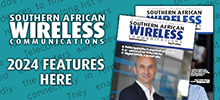04 July 2024
Future wireless broadband and home networks could be set for a significant speed boost after researchers discovered a way to curve light beams around objects.
The upcoming 6G standard is designed for peak data rates of up to 1Tbps and may be able to harness radio spectrum up to the TeraHertz (THz) bands, while using AI optimisations and new antenna designs to improve network efficiency.
Today’s mobile networks usually operate within the lower and mid-frequency mobile bands, such as between 700MHz and 3.8GHz, which enables signals to travel further. This sacrifices speed due to limitations on the available spectrum amounts; however, one workaround is to push mobile and WiFi networks to harness higher frequency bands. The challenge is that these higher frequencies make for extremely weak signals that don’t travel very far and are easily disrupted.
Researchers from Brown University and Rice University may have found a solution. The team has discovered a way of ‘curving’ light beams mid-air to help avoid physical obstacles, reducing the need for a line-of-sight connection. While light in the THz band prefers to travel in straight lines, the team found a rather more accessible approach to achieve a similar sort of outcome.
The researchers have introduced the concept of ‘self-accelerating beams,’ namely special configurations of electromagnetic waves that naturally bend or curve to one side as they move through space. The photons still travel in a straight line, but the THz signal effectively bends around the object.
Consequences from the curved beams like performance loss and distance limitations are still being worked on by the team, and quantification remains to be seen. However, the theory could prove an excellent boon to the upcoming 6G standard of mobile communications technology.







